8 steps to build a life coaching business—powered by community
Think life coaching is just a side hustle? Think again.
This 'hobby' industry is projected to grow from $3.2 billion (2022) to nearly $12 billion by 2032—faster than most Fortune 500 companies. More people than ever are seeking guidance, transformation, and connection, and life coaches are rising to meet that demand.
But here’s what most coaches don’t talk about: many feel stuck. Stuck offering only 1:1 sessions. Stuck trading time for money. Stuck running a business that’s tough to scale and even harder to sustain.
What can change that is building a community around your coaching business. A place where your clients can learn from you and from each other, while you gain more freedom and income potential.
If that vision speaks to you, stick with us. This guide will walk you through:
- How to launch an online coaching business with a community-first approach
- How to attract your first clients and scale your program
- How to set up your coaching business legally
What is life coaching?
Life coaching is a professional relationship where you, the coach, help clients achieve personal or professional goals. This could be anything from helping somebody build a more fulfilling career to improving their health and well-being.
As a coach, you help clients:
- Set clear goals
- Work through obstacles
- Build the mindset and skills they need to move forward
In short, you empower people to take action and create the life they want.
Benefits of life coaching
Coaching is a great business to be in. The stat we shared earlier reflects just how fast the global coaching market is growing. There are plenty of other reasons to pursue coaching, especially if you’re passionate about helping others.
- It drives results—and demand. Clients get meaningful results, which fuels referrals and repeat business. One study found that individual coaching improves goal attainment and motivation far beyond what people can achieve alone.
- You can have a profound impact on someone’s life. A study in Mayo Clinic Proceedings discovered that wellness coaching significantly improved participants’ quality of life, mood, and stress, and those benefits lasted well beyond the program. Helping clients experience these kinds of breakthroughs makes coaching a rewarding career.
- It scales beautifully. Start with 1:1 coaching, then expand to group programs, communities, courses, and memberships.
- Coach from anywhere. Build a location-independent business and work with clients worldwide.
- Low startup costs, high margins. Coaching has minimal overhead—a laptop, a coaching platform, your brain, and a payment processing tool are all you need, meaning more profit stays in your pocket.
Types of life coaching
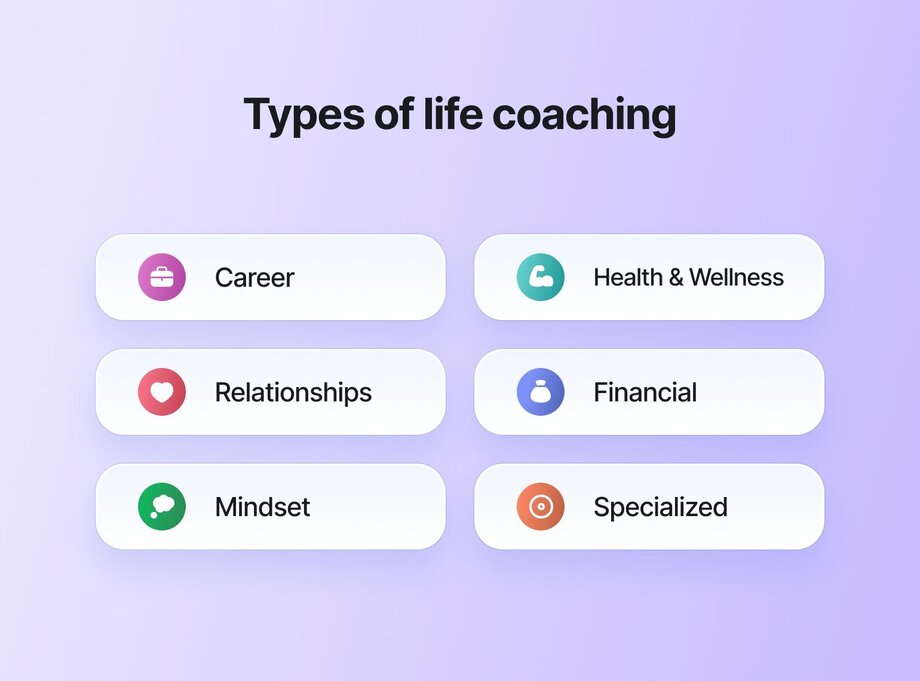
Life coaching is a wide-open field, which means you can build a business around almost any passion or area of expertise. Some in-demand coaching niches include:
- Career and professional coaching: Guide clients through career changes, leadership development, and finding meaningful work.
- Health & wellness coaching: Help clients build healthy habits, improve fitness, and manage stress.
- Relationship coaching: Support clients in strengthening relationships, improving communication, and resolving conflicts.
- Financial coaching: Help clients manage money, build confidence, and achieve financial goals.
- Mindset and personal development coaching: Empower clients to shift limiting beliefs, build confidence, and grow.
- Specialized coaching niches: Support clients through specific experiences—ADHD, parenting, pregnancy, burnout, sleep issues, divorce, and more.
Start a community-based life coaching business online in 8 steps
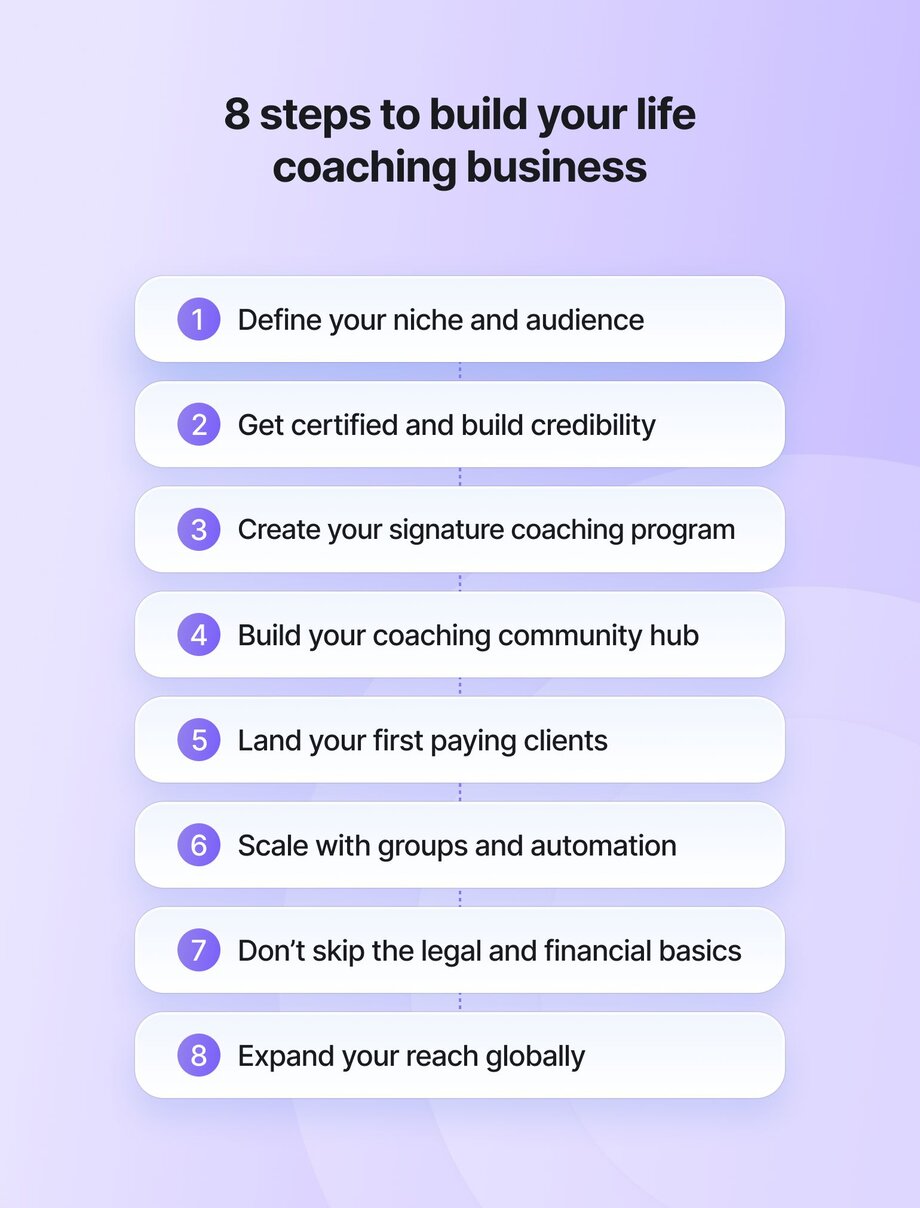
Now that you know what life coaching is—and the many niches you can work within—the next question is: how do you actually build a coaching business that works?
Let’s walk through the key steps to launching an online coaching business that puts community at the center—so you can grow your impact, create more income potential, and give your clients a powerful sense of connection.
Step 1: Define your niche and audience
Your coaching niche isn’t going to be random. It’ll likely be something you’re already passionate about—and have real experience with. After all, it wouldn’t make much sense to coach people on fitness if your idea of cardio is walking to the fridge, right?
You can start with a broad or abstract niche, but then you need to refine it as you go. Here’s how👇
Research in-demand areas
Look at where there’s real interest and need. Career transitions, wellness, relationships, and productivity are evergreen markets. Dig into Google Trends, Reddit threads, Facebook groups, and coaching directories to see what’s resonating—and where gaps exist.
Validate your niche
Once you’ve picked a general direction, the next step is to test it. One of the best ways? Start a community where people can gather, ask questions, and talk about what they’re struggling with. You’ll very quickly be able to spot patterns in what they need, where they’re getting stuck, and how you can potentially help them.
💡Need help narrowing your focus? This find your niche playbook from Codie Sanchez walks through how she turned laundromats into an 8-figure business.
Position yourself
It’s not enough to have a niche. You also need a point of view within that niche.
Ask yourself:
- Why should someone hire me over another coach?
- What makes my approach different?
- Do I have unique life experiences that shape my coaching?
- Are my coaching methods different from others in my niche?
The goal here isn’t to sound unique on paper. It’s to create a coaching brand that attracts the right people and repels the wrong ones.
👉 If you’re wondering how to position yourself so the right clients say yes faster, Maya Elios’ brand messaging framework is a great place to start.
Step 2: Get certified and build credibility
Do you need a certification to become a life coach? Technically, no.
Coaching isn’t a regulated industry yet, though some niches (mainly in health) do require official certification. But if you want to stand out in a crowded market, build trust, and charge premium rates, training helps. A lot.
Life coaching certification options
There are hundreds of certification programs out there, each with different strengths depending on what kind of coach you want to become.
- ICF (International Coaching Federation): The most recognized global accrediting body. If you want legitimacy in nearly any niche, an ICF-accredited program is a solid bet.
- NBHWC (National Board for Health & Wellness Coaching): Excellent if you lean toward health coaching.
- The CaPP Institute: Focused on personal and executive coaching, this program is rooted in positive psychology and practical business development. Ideal if you want to combine personal growth with coaching.
- CTEDU (Coach Training EDU): Great for academic, executive, and wellness coaching. Offers strong business-building support and an active alumni network.
Building credibility without years of experience
Another reason to get certified is that if you’re an aspiring coach, breaking into the market can take you years. Certification helps fast-track that process. It gives you a structured way to learn, practice your skills, and build trust with potential clients more quickly.
That said, personal experience in whatever you’re coaching matters a lot, too. If you’re 20 and offering menopause coaching, it probably won’t get you much work. People want to work with someone who’s walked a similar path.
Creating your coaching philosophy and methodology
Through these programs, you’ll also learn how to coach ethically and effectively—and how to shape a coaching philosophy that reflects your personality, strengths, and values. You’ll also practice crafting a repeatable method or framework, which will help your work feel grounded and clear.
Budget breakdown for certification & setup
So, if you’re thinking of getting certified, here’s a rough estimate of what to budget for courses and initial business setup costs.
| Expense | Cost range (USD) |
|---|---|
| Coaching certification (6–12 months) | $2,500 – $13,000 |
| Business setup (website, LLC, tools, etc.) | $300 – $1,000 |
| Optional: Brand design, copywriting help, ads | $500 – $2,000 |
| Total estimated investment | $3,300 – $16,000 |
Step 3: Create your signature coaching program or framework
At this point, you’ve validated your niche and started building credibility. Now it’s time to create your signature coaching program—your unique process for helping clients achieve transformation.
Outline your coaching philosophy and methodologies
Your coaching philosophy is the foundation of your work. It reflects your core beliefs about how people change—and how you help facilitate that change. Whether it draws from positive psychology, behavior change models, mindset coaching, or a blend of disciplines, your philosophy should feel both authentic and actionable.
But philosophy alone isn’t enough. You also need to translate it into practice. This is where your methodologies (acquired through certification or experience) come in: the tools, exercises, and frameworks that give your clients a clear path forward.
👉 A great example of this in action is Erin Wong, who runs Thriving Minds at Work, an online coaching community for working women navigating ADHD, ASD, mood disorders, and life transitions. Erin brings her philosophy to life through individualized executive function coaching paired with lifestyle, stress, and self-care strategies. Her clear methodology helps clients build sustainable habits and lasting personal growth.
When you define your philosophy and methods this clearly, your coaching becomes both more impactful and more marketable. Clients know exactly why your approach is worth choosing.
Structure group coaching programs vs. 1:1 sessions
There are two main ways to structure your coaching program:
- 1:1 sessions. This is where most coaches start—and for good reason. Your clients get personal attention, and you get to hone your skills fast. The downside? Your earning potential is capped as there are only so many hours in a day.
- Group coaching + community. This is how seasoned coaches scale. Group coaching lets you work with more clients at once while creating a shared learning experience. Add a community (with tools like Circle), and now your clients stay engaged and connected between sessions. They learn from each other, not just you, while you build a business that can grow without running you into the ground.
👉 The Pilot Institute Premium Drone Community by Greg Reverdiau is a perfect combination of community and coaching in one. Members get access to expert-led sessions, peer support, workshops, and a full drone business course—all designed to help them grow faster without going it alone.
Price your program based on its value
Don’t charge by the hour is the most important rule when it comes to pricing. Instead, price based on outcomes—the transformation you’ll help your clients achieve. Moreover, do your research: look at what similar coaches charge and use that as a benchmark.
If you need a super basic pricing strategy, you can also use broad pricing bands:
- Community (ongoing monthly membership): free–$199/month
- 1:1 coaching (3-month package): $1,500–$5,000
- Group coaching (6–12 weeks): $500–$3,000 per participant
Develop curriculum and session formats
It’ll be hard to sell a coaching program if it’s not clearly structured. Give people a clear sense of what they’ll get out of coaching—and how they’ll get there. That means you need to define:
- Program outcomes
- Structure
- Session formats
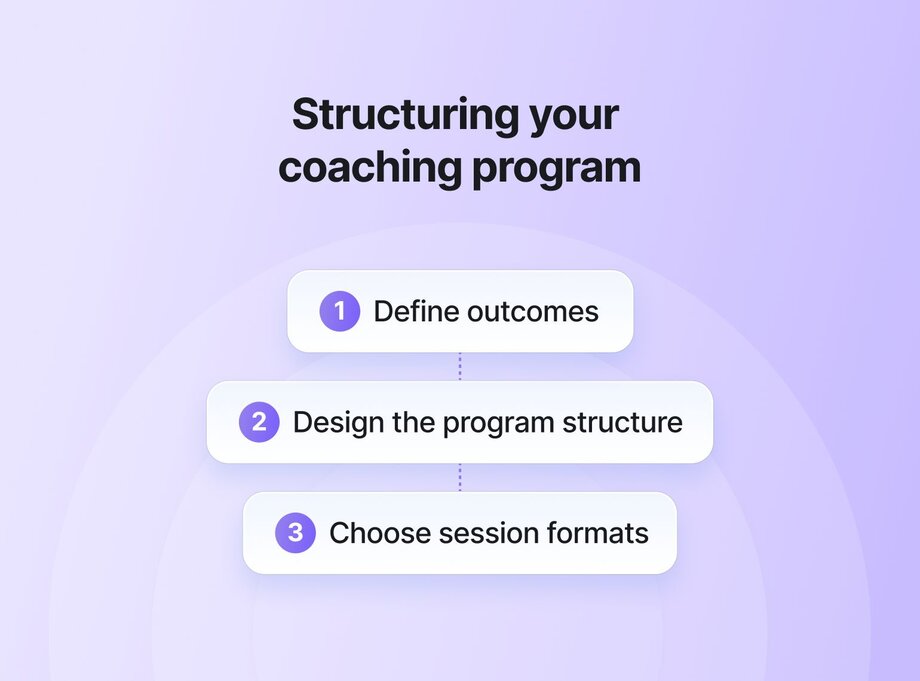
How to structure your coaching program
1️⃣ Define outcomes
→ What transformation will your clients experience?
→ What skills or results will they walk away with?
2️⃣ Design the program structure
→ Duration (e.g. 6 weeks, 3 months, ongoing)
→ Number of modules or key topics
→ Weekly cadence or rhythm (weekly, bi-weekly, monthly)
3️⃣ Choose session formats
For 1:1 coaching:
→ Live video calls (Zoom, Meet)
→ Asynchronous coaching via voice notes (e.g., Voxer)
→ Personalized homework & feedback
→ Email check-ins
For group coaching:
→ Weekly or bi-weekly group calls
→ Live workshops
→ Breakout group discussions
→ Guest expert sessions
→ Community forum or chat for ongoing connection
Step 4: Build your coaching community hub
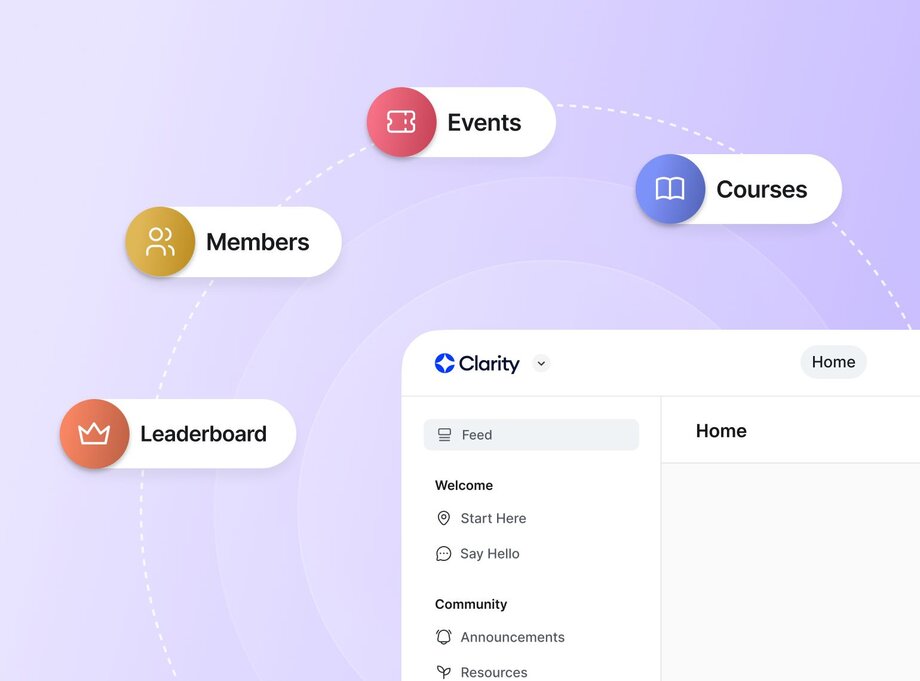
You’re halfway through—great job! Now’s a good time to think about your coaching community hub. This is pretty much your virtual HQ for running your business and building deeper relationships with your clients.
Set up your coaching community
If you want your community to power your business, you need a platform that can actually power your community. A bunch of different tools scattered around won’t create that unified experience. You need something much more streamlined!
An all-in-one community platform like Circle brings together everything you need to run your coaching community business—discussion spaces, live events, courses, resources, payments, and even email marketing. With everything under one roof, you can build an engaged, thriving community that keeps clients coming back.
Create engagement that lasts
Once your community hub is in place, your next goal is to spark meaningful interaction. The strongest communities thrive when members feel connected, heard, and empowered.
Circle makes it easy to foster this dynamic:
✅ Discussion forums to give members a space to ask questions, share wins, and support each other
✅ Real-time chat spaces for casual conversations and deeper connections
✅ Curated personal home feeds to surface the most relevant conversations and content
✅ Automated weekly email digests keep your members coming back
Integrate courses, resources, and live coaching
To deepen the value of your community, integrate your core coaching offers inside your hub. With Circle, you can host courses, upload resources, and run live coaching sessions—all in one place. This makes it seamless for members to move between learning and applying, between consuming content and getting coached.
Health coach Mila Clarke used Circle to build Glucose Guide Diabetes Support, a 1,000+ member community where people with diabetes can access coaching, recipes, live classes, and evidence-based studies via a custom app. And yes, that app? Built on Circle.
Step 5: Launch and land your first paying clients
If you’re like most new coaches, landing your first paying clients will feel both thrilling and a little terrifying. The key? Treat client acquisition like any other skill: build it step by step, with consistent daily action.
Pre-launch strategies: beta clients and testimonials
Before you launch publicly, coach a few beta clients for free or at a discounted rate. This lets you refine your coaching and collect all-important testimonials you can use to build trust with future clients.
Just don’t wait until you feel “ready.” As Kate Solovieva, a coach who helps other coaches build sustainable, client-centered businesses, puts it:
“Start telling people AS YOU GO. Do not wait until you have some magical certification or piece of paper in hand. Nothing happens when you cross that threshold. Start telling people AS you are doing it. Share what you learn as you are learning it…
Make sure every single person you know knows what you do and that you are taking on clients.”
–Kate Solovieva, Life Coach for Coaches, and Director of Community Engagement at Precision Nutrition
In other words, start talking about your coaching now. The more visible you are, the easier it will be to fill those first beta spots and start building momentum.
Marketing tactics that work for coaches
In coaching, happy clients are your best marketing team. Referrals carry more weight than any ad ever will. That said, you should still actively build your personal brand and marketing funnel:
- Top of funnel: If you have a social media following, use it to your advantage. Start sharing what you’re learning and offering as a coach to build awareness of your business. If you don’t have any following, you can build it through sharing helpful tips and other educational posts on the platforms where your ideal clients hang out.
- Middle of the funnel: Consider offering a mini freebie like a “3-step mindset shift guide” in exchange for emails. Then nurture that email list with valuable tips and stories that build trust.
- Bottom of the funnel: At this point, you’ll be looking at converting your audience into actual sales. For example, you can offer a free 30-minute coaching session or free 1-month access to your community.
Converting community members to paying clients
Not all community members will be ready to join your coaching programs yet. Maybe it’s budget, maybe timing, maybe something else. But they’re still warm leads.
Consider offering exclusive perks to your community members, like early access to new coaching programs or member-only discounts. And take the time to engage with them personally. Reply to comments, ask questions, and start conversations. You need to build relationships first. Sales will come later as a result.
Step 6: Scale through group programs and automation
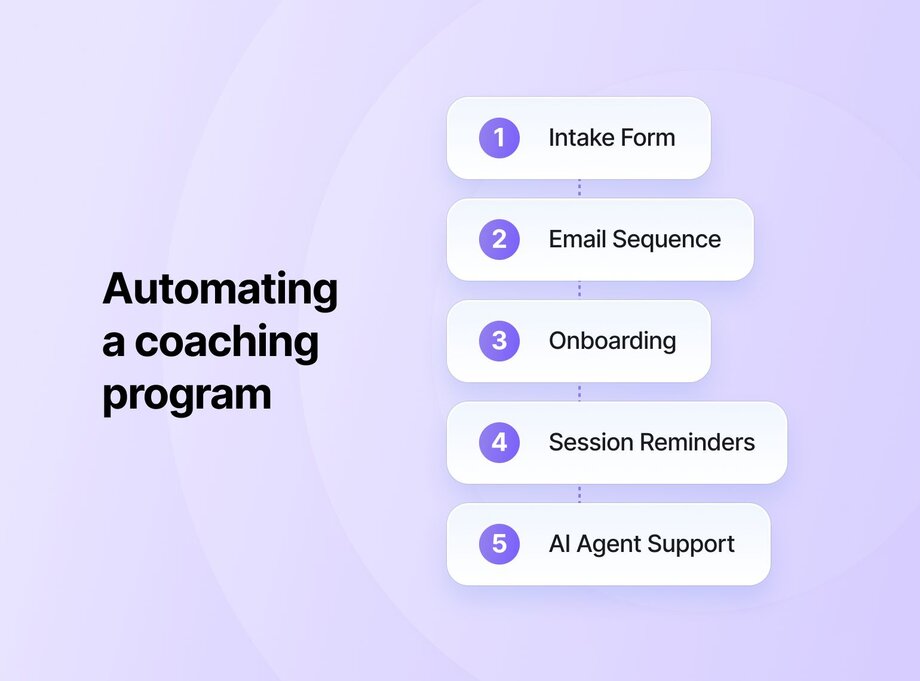
Once you’ve set up your community (and maybe done a few 1:1 sessions), it’s time to think about scale. That involves going all in on group coaching and automation.
Double down on group programs
Group coaching programs are often the first big lever for scale. They not only let you help more people at once but also create powerful peer learning environments. A well-designed group experience can deliver as much transformation as 1:1 work—sometimes more.
Start by packaging your proven 1:1 frameworks, then layer in collaborative exercises, shared discussions, and community touchpoints.
Automate to save time
As you scale, your time becomes your most valuable asset. Use AI tools and automations for scheduling, client reminders, intake forms, onboarding sequences, and even personalized content delivery.
Tools like Circle’s AI Agents and Community AI can help here. For example, you can build personalized AI Agents to guide, coach, and support members 24/7, trained on your posts, comments, courses, and resources. Or tap into AI Summaries to stay on top of what’s happening in your community by quickly surfacing key insights from posts, comments, and spaces.
Create passive income
You should also productize your coaching frameworks into online courses, digital workbooks, or ebooks. These can generate revenue without requiring your constant presence, and help you serve clients at different price points.
💡 Not sure where to start with product creation? Check out our guide on how to create digital products your audience will love (and buy).
Step 7: Don’t skip the legal, financial, and operational must-dos
Before you start working with clients (and charging them), make sure your legal, financial, and operational ducks are in a row.
Business structure
Most coaches choose between setting up as a sole proprietorship or forming an LLC (Limited Liability Company)—or whatever the equivalent is in your country.
- A sole proprietorship allows you to start coaching right away under your own name. But there’s no legal separation between you and your business. If someone sues you, your personal assets (car, house, savings) could be at risk.
- An LLC adds a layer of protection. It costs a little to set up (varies by state), but it shields your personal assets if things go south.
Whichever path you choose:
✅ Set aside money for taxes (yes, coaching income is taxable)
✅ Consider basic liability insurance—it’s peace of mind in case a client ever claims harm or takes legal action
Client contracts and liability considerations
Always have a written coaching agreement. This protects both you and your clients by setting clear expectations around cancellations, confidentiality, and the scope of services. It doesn’t have to be fancy—you can find coaching contract templates online and adapt them to your needs.
Financial tracking and pricing adjustments
Track what’s coming in and what’s going out. A spreadsheet is fine at the beginning, or you can use tools like QuickBooks or Wave. Also, review your pricing every few months. If your programs are consistently booked out, that’s a sign it may be time to bump those rates.
Maintaining coaching ethics and boundaries
Stick to your role. You're not a therapist, doctor, or financial advisor unless you're certified in those areas. Follow the ethical standards of whichever coaching body you align with (like ICF) and don’t be afraid to refer a client elsewhere if coaching isn’t the right fit for their needs.
Step 8: Expand your reach globally
One of the coolest things about running an online coaching business? You’re not bound by borders. Your ideal client could be in New York… or New Zealand.
To reach global audiences:
- Be visible and post on social media platforms like LinkedIn or TikTok, where global audiences hang out
- Run ads targeted at international markets
- Launch email campaigns segmented by country or region
- Offer key content, like your sales pages or onboarding emails, in multiple languages
One wise word of caution: be aware of cultural differences. What resonates in the U.S. may not land the same way in Europe or Asia. Stay curious, and be ready to adapt.
✨Bring your coaching business vision to life
You now have the 8-step playbook to launch and grow your coaching business. Do give yourself grace, though. Most coaches take 3–6 months to launch and 12–18 months to reach profitability. But those who build strong communities from day one? They scale faster and build more resilient businesses.
Build a space where people connect, learn, and grow with you and with each other on Circle.
FAQs
How much does it cost to start a life coaching business?
You can get started for as little as $500. Essentials include a laptop, a website, email marketing software, and a coaching platform. If you pursue certifications or training, plan to invest another $1,000–$5,000. Many coaches start lean and reinvest profits as they grow.
Do you need an LLC to start a coaching business?
No, but it’s a good idea. An LLC (Limited Liability Company) protects your personal assets if legal issues arise. You can absolutely begin as a sole proprietor, but forming an LLC adds credibility, simplifies accounting, and is well worth doing once your income becomes consistent.
Is life coaching a profitable business?
Yes, life coaching can be very profitable. With low overhead, high hourly rates, and scalable offerings like group programs or online courses, many coaches build six-figure businesses. However, profitability depends on your ability to market, sell, and deliver real results for clients. Coaching is a business. Treat it like one.